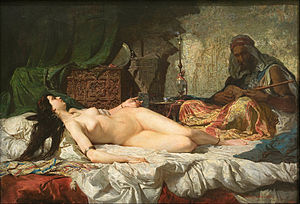Odalisque
This article does not have any sources. (September 2023) |
| Part of a series on |
| Slavery |
|---|
 |


An odalisque (Ottoman Turkish: اوطهلق, Turkish: odalık) was a chambermaid or a female attendant in a Turkish seraglio, particularly the court ladies in the household of the Ottoman sultan.
In orientalist art[change | change source]
In western usage, the term came to mean the harem concubine. They were often shown in paintings.
They started a genre. In these pictures, a woman is shown mostly or completely nude in a reclining position, often in the setting of a harem.
Original usage of the term[change | change source]
In the original usage of the term, an odalisque was at the lower social levels of a harem. Odalıklar did not serve the master of the harem. They served his wives and concubines as a chambermaid. Usually, odalikar were slaves, that were given to the Sultan by wealthy Turkish men. Most of the time, they were slaves from Georgia, or Circassia.
Generally, an odalık was never seen by the sultan but instead remained under the direct supervision of his mother, the Valide sultan.
If an odalık was very beautiful or had exceptional talents in dancing or singing, she would be trained as a possible concubine. If selected, an odalık trained as a court lady and would serve the sultan sexually. Only after such sexual contact would she change in status, becoming one of the consorts of the sultan.
Note that the contacts between the sultan, his sons, and the girls and women of the harem were strictly regulated. Most members of the harem had to lead a life of sexual abstinence. In that way, a harem was more like a monastery.


